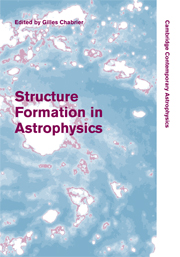Book contents
- Frontmatter
- Contents
- List of contributors
- Preface
- Part I Physical Processes and Numerical Methods Common to Structure Formations in Astrophysics
- Part II Structure and Star Formation in the Primordial Universe
- Part III Contemporary Star and Brown Dwarf Formation
- Part IV Protoplanetary Disks and Planet Formation
- 13 Observational properties of disks and young stellar objects
- 14 Structure and dynamics of protoplanetary disks
- 15 Planet formation and evolution: theory and observations
- 16 Planet formation: assembling the puzzle
- Part V Summary
14 - Structure and dynamics of protoplanetary disks
Published online by Cambridge University Press: 11 August 2009
- Frontmatter
- Contents
- List of contributors
- Preface
- Part I Physical Processes and Numerical Methods Common to Structure Formations in Astrophysics
- Part II Structure and Star Formation in the Primordial Universe
- Part III Contemporary Star and Brown Dwarf Formation
- Part IV Protoplanetary Disks and Planet Formation
- 13 Observational properties of disks and young stellar objects
- 14 Structure and dynamics of protoplanetary disks
- 15 Planet formation and evolution: theory and observations
- 16 Planet formation: assembling the puzzle
- Part V Summary
Summary
Introduction
The dust and gas disks surrounding many pre-main-sequence stars are thought to be the birthplaces of planets. They are therefore the locations of structure formation in the universe, albeit on small scales. In recent years, the topic of protoplanetary disks has gained an increasing amount of attention in astrophysics, which is in large part due to the enormous increase of high-quality observational data that have been published recently, from the Spitzer Space Telescope, from the Very Large Telescope, from millimetre interferometers and so forth. Moreover, studies of the properties of extrasolar planetary systems have put new constraints on the formation and migration of newly born planets in such disks. The topic of the structure and evolution of protoplanetary disks is wide open, and significant new developments, both from theory and from observations, can be expected in the near future.
This chapter gives an overview of some aspects of theoretical modelling of protoplanetary disks. The review consists of four parts. First, we discuss the overall formation, evolution and dispersal of protoplanetary disks. We show that much of what we know of the long timescale disk evolution is still based on relatively simple models. We discuss their vertical structure, as derived from radiative transfer models and their comparison to observations.We then show that magneto-rotational and gravitational instabilities (GIs) can introduce complex dynamics and non-linear structure to these disks, and we discuss an on-going debate about the role of GIs in planet formation.
- Type
- Chapter
- Information
- Structure Formation in Astrophysics , pp. 350 - 377Publisher: Cambridge University PressPrint publication year: 2009
- 2
- Cited by

